Chamber / Taperstick / Snuffer
Chamber / Taperstick / Snuffer
Browse our collection of antique silver Chambersticks, Tapersticks, Candle Snuffers and Stands, some of which date back to the 17th century.
Silver chambersticks first made an appearance in the 17th century and early examples are now very hard to find. Originally they were made in sets as a household would need many chambersticks. They were used for lighting the way to bed and because of the movement created when they were carried about they needed a large drip pan to catch the wax. The earliest examples have straight handles (first flat, then tubular) which were superseded in the first part of the 18th century by a ring handle. Gradually the design evolved and from the mid 18th century onwards they usually had a matching conical snuffer although from about 1790 onwards some were made with an aperture at the base of the stem to take a pair of scissor snuffers.
Silver tapersticks, averaging about 5 inches high, are miniature table candlesticks used to hold a wax taper. Tapersticks would typically be found on a desk as they were not used for lighting; the melted sticks of wax were used for sealing letters, to give a flame for tobacco pipes or to light large candles. They are rarer than candlesticks and very few existed prior to the Queen Anne period. They usually appear in singles and pairs of tapersticks command a premium price.
The silver wax jack appeared from circa 1775 and was a container or frame holding a long coiled taper treated with wax (sometimes turpentine). The wax was lit to melt the sealing wax used to fasten letters and documents and usually a personal seal was pressed into the hot wax to leave a personal identification. After the wax hardened it was virtually impossible to open the letter without breaking the wax seal. The wax jack could also used as a portable light such as the chamber stick or go to bed.
Silver candle snuffers and stands were vital pieces of equipment to enable candle lighting to be used efficiently. Two different types of candle douters were used to extinguish the flame of a candle:
– the candle snuffer with a small cone on the end of a long handle.
– the snuffer scissors, a dual purpose tool which could extinguish the candle flame and also cut the wick of the candle for reuse. The pointed end was used to loosen and remove candle stubs from the socket.
There were few snuffers made prior to 1700 and by the early nineteenth century more refined candles were introduced which no longer required the wick to be cut. Additional information available at http://www.oldandinteresting.com/tallow-candles-snuffers.aspx. Snuffer trays are usually rectangular or oval shaped and can sometimes be raised on feet or have a carrying handle. Some early stands, called standing snuffers, are shaped like a candlestick with a side carrying handle and a hole at the top where the point of the snuffer scissors is inserted – these were very quickly superseded by the flat snuffer tray and scissors. It is rare now to find matching snuffers and base. Snuffers and trays were usually made by different specialists so even though the dates match, the makers will probably be different.
-


1686
10450 James II Antique Silver Chamberstick
Reserved
A distinctive little chamberstick (or “go to bed”) with the solid design and heavy gauge silver you’d expect from this date. It has the early form with a flat teardrop handle engraved with a family coat of arms. The circular pan has a gadrooned border and ribbed sconce, all mounted on three small stump feet. Weight 187g, 6 troy oz. Height 4.3cm. Diameter 9.7cm. Spread 15cm, 5.9ins. London 1686. Maker’s mark unclear. Sterling silver.
-

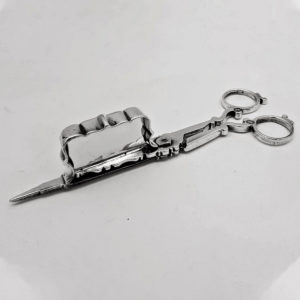
1701
Thomas Brydon
10371 William III Silver Snuffer Scissors
Sold
A rare early English silver candle douter, also called a wick trimmer, with the simple plain style typical of the period. *Britannia standard silver. Weight 94 grams, 3 troy ounces. Length 15.9cm. Width 5.5cm. London 1701. Few snuffers were made prior to 1700. Maker Thomas Brydon, see Jackson’s Silver & Gold Marks page 154, a known snuffers and stand maker.
-

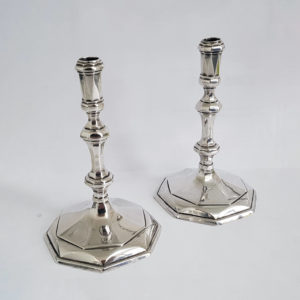
1712
Joseph Bird
10232 Queen Anne Antique Silver Tapersticks
A rare pair of dainty little antique silver tapersticks with the desirable octagonal shape. Superb quality. Lovely crisp finish. The straight lined form features a faceted sconce and foot and a plain knopped tapering stem. Total weight 200 grams, 6.4 troy ounces. Height 12cm. Base diameter 7.1cm. London 1712. Maker Joseph Bird. Britannia standard silver. 18th century.
-

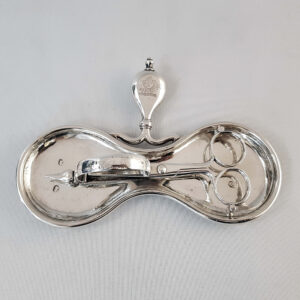
1716
George Gillingham
10418 George I Antique Silver Snuffer Tray and Scissors
It’s unusual to find a completely matching candle snuffer set from this early date, particularly with these attractive features. The scissor stand has an hour glass form, with the flat teardrop handle and small ball feet similar to early chambersticks of that date. The candle douter and wick trimmer has a simple open and shut mechanism and retains the original steel cutting plates, the pointed end was used to loosen and remove candle stubs from the socket. Both pieces bear the attractive hand engraved crest of a stallion horse.
-


1722
Matthew Cooper
10448 George I Antique Silver Taperstick
An elegant little antique silver taperstick with knopped stem and rectangular base. Classic plain style and straight lines. Hand engraved to the foot is the crest of a fleur de lys with crown below. Cast silver. Weight 101 grams, 3.2 troy ounces. Height 9.8cm, 3.8ins. Diameter of base 6.7cm, 2.6ins. London 1722. Maker Matthew Cooper. Sterling silver.
-

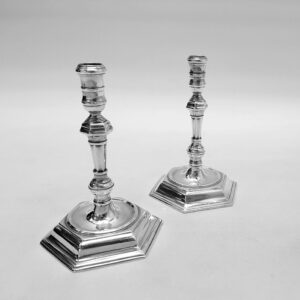
1724
John Bache
10302 George I Antique Silver Tapersticks
A delightful pair of little antique silver taper sticks with the plain hexagonal design typical of the early 1700’s. Cast silver. Total weight 235 grams, 7.5 troy ounces. Height 11.4cm. Base measures 7 x 8cm. London 1724. Maker John Bache. Britannia standard silver – 95.8% purity*. 18th century.
-

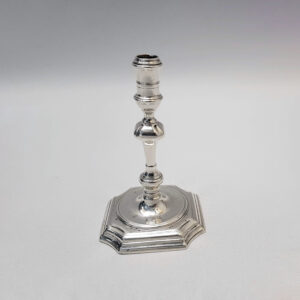
1730
John Bache
10363 George II Antique Silver Taperstick
A delightful little antique silver taper stick of plain early design with baluster stem and square octagonal foot with a sunken well. Nice plain style and straight lines. Cast silver. Hand engraved within the well is a “hand” crest. Weight 94g, 3.0 troy oz. Height 10.5cm. Base diameter 6.5cm. London 1730. Maker John Bache. Sterling silver. This taperstick would make a good pair with #10360 (minor differences).
-


1733
David Willaume
10447 George II Antique Silver Chamberstick
Reserved
A plain style silver chamber stick (or “go to bed”) from the early 1700’s with a simple C shaped handle and reeded rim. Solid design and excellent heavy gauge silver as you’d expect from this date. An unusual feature is the decorative band of trellis hatching with shells and scrolls, hand engraved to the top surface. Weight 304g, 9.7 troy oz. Diameter 13.5cm. Spread 17cm, 6.7ins. Height 6.5cm. London 1733. Maker David Willaume, an important Huguenot maker. Sterling silver.
-

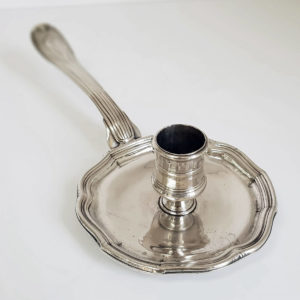
1746
9642 Antique French Silver Chamberstick
A good quality antique silver chamber stick of early form having a long flat handle and broad drip pan. With the solid cast design and excellent heavy gauge silver as you’d expect from this date. Hand engraved to the front is an armorial within a decorative cartouche (worn). Weight 217 grams, 6.9 troy oz. Diameter 10.4 cm. Length 22.5 cm. Marked underneath with French silver marks for Paris, date mark “F” for 1746. Maker’s mark indistinct.
-

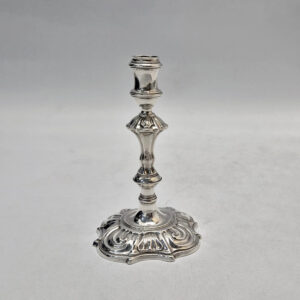
Circa 1750
10461 George II Antique Silver Taperstick
A pretty little antique silver taperstick with shaped decorative base and knopped baluster stem. Cast silver. Weight 128g, 4.1 troy oz. Height 11.9cm, 4.6ins. Base 7.7cm, 3ins. Unmarked silver. Circa 1750. Sterling silver.
-


1754
Dougal Ged
10456 George II Scottish Antique Silver Chambersticks
Sold
A stunning pair of antique Scottish silver chambersticks of plain circular form with a ‘C’ shaped handle. Total weight 436g, 13.5 troy oz. Diameter 13cm, 5.1ins. Spread 14.5cm, 5.7ins. Height 6.5cm, 2.5ins. Edinburgh 1754. Maker Dougal Ged.
-


1764
Ebenezer Coker
10451 George III Antique Silver Taperstick
A pretty little antique silver taperstick with shell base and detachable nozzle. Made of cast silver. Attractive detail with a rope twist ornament to the top and column and there is a hand engraved cypher to the sconce. Weight 170g, 5.4 troy oz. Height 13.8cm, 5.4ins. Diameter of base 8.8cm, 3.4 ins. London 1764. Maker Ebenezer Coker. Sterling silver.
-

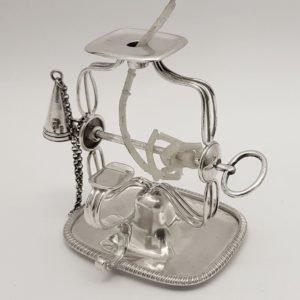
1807
James Turner
9604 Georgian Silver Wax Jack
Sold
A rare antique sterling silver wax jack, or go to bed, of rectangular form. Good plain style and gadroon borders. The central wax winder supports the remains of a coil of wax, the end of which is held in place in the centre of the sconce. The small conical snuffer is attached to the top by a long silver chain. Weight including wax 163 grams, 5.2 troy ounces. Height 11 cm. Base 9.3 x 7.4 cm. London 1807. Maker probably James Turner.
-

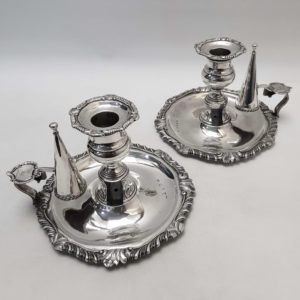
1817
James Scott
10190 George III Antique Silver Chambersticks
A fabulous pair of antique Irish silver chambersticks of particularly large size and heavy gauge silver. Plain classic Georgian style with broad gadroon borders, detachable nozzle and snuffer, and attractive shell thumbpiece with a stag crest. Total weight 1211 grams, 38.9 troy ounces. Height 12cm. Diameter 17cm. Spread 18.5cm. Dublin, Ireland 1817. Maker James Scott. Sterling silver. 19th century.